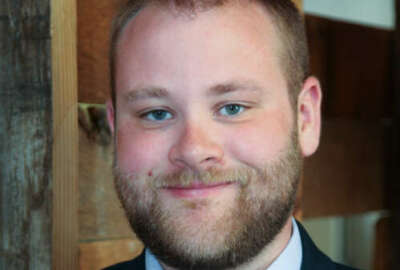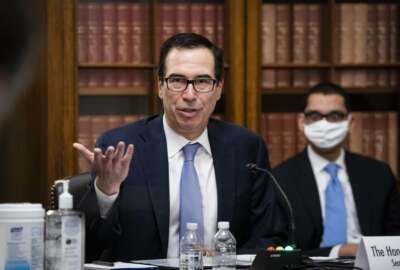
Starting a new oversight commission with a huge task
When the CARES Act passed, lots of people got jobs to do in disbursing more than $2 trillion. Inspectors general got the job of holding everyone accountable.
Best listening experience is on Chrome, Firefox or Safari. Subscribe to Federal Drive’s daily audio interviews on Apple Podcasts or PodcastOne.
When Congress passed the CARES Act a thousand years ago in March, lots of people got lots of jobs to do in disbursing more than $2 trillion. Inspectors general got the job of holding everyone else accountable. For what it was like from the inside standing up the Pandemic Response Accountability Committee, or PRAC, Federal Drive with Tom Temin turned to its executive director, Robert Westbrooks.
Interview transcript:
Tom Temin: Mr. Westbrooks, good to have you on.
Robert Westbrooks: Hi, Tom, good to be here. Thank you.
Tom Temin: Well tell us what it was like setting up something so quickly and with such public scrutiny and congressional scrutiny as this whole thing has been getting.
Robert Westbrooks: Starting up a new federal agency to oversee the historic amount of emergency relief in a global pandemic is no easy task. CARES Act was signed on March 27. The IGs came together immediately to organize and plan next steps. There was a 30 day requirement built into the act to name and executive director, to select PRAC members, committee members among the IGs, and to launch a website. And so I was named on April 27, and reported for duty immediately and we’ve been going ever since, a very short takeoff runway. We started off with initial staff was borrowed resources from OIGs, and we quickly transition to reimbursable details, and now we’re staffing up with permanent career hires and interagency agreements for shared services.
Tom Temin: Interesting. And when you say that you started meeting, usually agencies the first thing they do is find office space and move in there. Has it all been virtual or has there been any in person contact at this point, given the pandemic?
Robert Westbrooks: Well, given the pandemic, we’ve been operating in the cloud, we are a distributed workforce in a virtual workplace, but we haven’t missed a beat on that. The PRAC itself meets every Tuesday, at least once a week we have meetings where we get together to discuss issues of common concern. And then we have subcommittees of PRAC members that, healthcare is one in particular, spend a lot of time identifying cross cutting issues in the public health space.
Tom Temin: And there’s a lot to look at here I guess considering all of the provisions in the CARES Act. Some of the inspectors general like Treasury inspector general for tax administration, and HHS and some of the other agencies, SBA, are looking at what their agencies did anyway as they would as IGs. So where does what they’re looking at and overseeing and assessing leave off and the PRAC takeover?
Robert Westbrooks: Yeah, that’s a great question. First let me say, I can say this subjectively since I’m no longer an IG, I’m absolutely amazed that the dedication and work of the individual IGS and the PRAC members. They have day jobs that have gotten significantly more difficult with the pandemic and with the CARES Act. But what we look at our cross cutting issues — risks that cut across agency boundaries and program boundaries. So we are by law not to duplicate or overlap what’s going on, so we’re looking for the whitespace between what OIGs are doing to add value, and sometimes that’s bringing folks together, sometimes it’s supporting the ideas and sometimes it’s doing our own independent oversight.
Tom Temin: And what is your initial list of issues to look at and to delve into?
Robert Westbrooks: Well Congress was kind enough in the CARES Act to identify a number of oversight projects for us. A lot of them are in the areas that one would expect, that the American people should expect, which is in contract oversight, grant oversight. And these are things like looking at sole source contracts, looking at training and adequacy of acquisition staff, looking at fraud and trying to identify fraud and contract and grant spending. So we’re going to we just issued a strategic plan this week with four strategic goals. So we’re executing under that strategic plan and alignment with the statute.
Tom Temin: Yeah, I wanted to ask about that strategic plan, because that did just come out, I think, just a couple days ago, late last week. So tell us some of the elements in there, what’s important there.
Robert Westbrooks: The important stuff, some of it is things that one would expect, right. Our core mission is preventing and detecting fraud, waste, abuse and mismanagement. We also have a transparency mission, which is our public website, pandemic.oversight.gov, which I encourage your listeners to go to, we’ll be launching a revised website, a 2.0, later in the fall. But where a lot of our energy is going to be focused is this idea of promoting coordinated, comprehensive oversight that doesn’t overlap with the IGs. And then the fourth goal that we have is ensuring effective and efficient PRAC operations, right. We should be promoting the leading edge practices and government management while we’re doing this oversight work.
Tom Temin: And we should point out that the strategic plan goes to 2025. So this is not a flash in the pan type of operation, is it?
Robert Westbrooks: It is not and by statute, we’re a temporary corporation that exists for five years. So we need to hit the ground running and we are because we’ve got a five year mandate.
Tom Temin: Here’s a detailed question I had — Brian Miller who is the specialist Inspector General for pandemic response is also a member of the PRAC. How does that relationship work?
Robert Westbrooks: Brian is in fact another IG member of the PRAC. He’s responsible for a portfolio, the Treasury loans that he has direct oversight over, and we coordinate with him with his work just like we do with all the other 21 PRAC members.
Tom Temin: And you mentioned in the plan for oversight, sole source contracts, training of acquisition staff, those kinds of things. Those tend to be looking internally at agency operations for handling this money. And then there is the issue of did the right people get loans? Was there fraudulent payments to dead people?All these things that keep coming up. Are those external issues tending to be staying with the agency IGs and the operation of agencies internally? How good did they do acquisition? Did they use sole source contracts properly? Those kinds of questions. Those are mainly the PRAC side things?
Robert Westbrooks: So now that we have a strategic plan in place, and we’re staffing up, and we’ve got a stand up plan that’ll get us to full staffing and full strength by September 30. In developing individual work plan, that’s where we’ll identify roles and responsibilities between the PRAC and the individual IGs. Collectively though we’re all on the same pages. There’s a critical need now with Congress and policymakers that they need actionable insights now, and so we’re working with the individualized IGs to develop and produce agile oversight products that can add value and give you that quick insights.
Tom Temin: And as a matter of history or training yourselves, did you look at the RAC board for the economic response back in 2008-2009 and beyond when all those funds were committed? Anything that that group did helpful in guiding what the practice doing?
Robert Westbrooks: Yeah, absolutely. That’s the starting point for us. In fact, our statute in the CARES Act is modeled after the Recovery Act. So that’s our starting point. There are a lot of great lessons learned and best practices from that era that we’ll be replicating. But at the same time, times have changed and currently it’s about three times as much money and the velocity with which this money is going out the door makes it especially challenging for us, but they’re absolutely our inspiration and starting point, yep.
Tom Temin: Yeah cause their money was spent over a period of about two, two and a half years. In some cases, this was all two and a half months.
Robert Westbrooks: That’s correct. Kind of the mantra back then was shovel ready projects that you could go down the street in your local neighborhood or city and identify something tangible, infrastructure. It’s very different kinds of spending now so it presents unique challenges for us in tracking this money and providing accountability.
Tom Temin: And there might be another somewhere between a billion or 2 or 3 billion depending on which version and how they negotiate the Senate and the House, but looks like there’s more coming that will be under your purview to watch over.
Robert Westbrooks: Indeed. Our initial purview was the four pieces of legislation and then anything that follows comes under our jurisdiction.
Tom Temin: Have you been having a little bit of fun too maybe?
Robert Westbrooks: Well it’s a very serious mission, but it is exciting being able to work in this space because this is the mother of all oversight missions. And so for somebody that’s been in this business for 26 years, there can’t be a greater challenge. And all of the folks that we’ve attracted to our team share that vision of public service, it’s just we’re all drawn and call to this mission –so yeah, we’re having a little bit of fun.
Tom Temin: Yeah, maybe funs not the best word, but you’re sort of like a bass fisherman who’s got his first Marlin in open seas, and it’s a whole different scale, isn’t it?
Robert Westbrooks: I’ll go with that one. Yeah, absolutely. It’s different seas.
Tom Temin: Robert Westbrooks is executive director of the Pandemic Response Accountability Committee, and recently stepped down as Inspector General of the Pension Benefit Guaranty Corporation. Thanks so much for joining me.
Robert Westbrooks: My pleasure Tom. Thank you.
Copyright © 2024 Federal News Network. All rights reserved. This website is not intended for users located within the European Economic Area.
Tom Temin is host of the Federal Drive and has been providing insight on federal technology and management issues for more than 30 years.
Follow @tteminWFED
Related Stories





